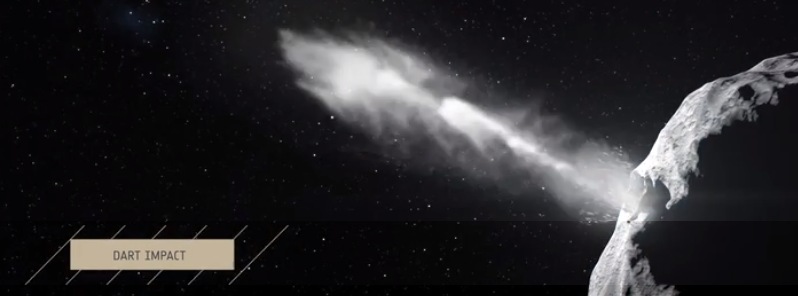Asteroid Impact Mission (AIM): Deflecting asteroids to protect Earth

Our planet is constantly bombarded by small asteroids that try to penetrate its protective atmosphere. The vast majority don't get through, but larger asteroids could pose a threat. Understanding better the surface and internal structure of asteroids is crucial in improving deflection technologies to set them off a collision course. This is one of the main objectives of Asteroid Impact Mission (AIM), ESA's candidate mission currently undergoing preliminary design work.
If approved, AIM will be launched in October 2020, and travel to a binary asteroid system – the paired Didymos asteroids, which will come a comparatively close 11 million km (6.83 million miles) to Earth in 2022. The 800 m-diameter (0.5 miles) main body is orbited by a 170 m (0.1 miles) moon, informally called ‘Didymoon’.
This smaller body is AIM’s focus: the spacecraft would perform high-resolution visual, thermal and radar mapping of the moon to build detailed maps of its surface and interior structure.
The main AIM spacecraft is planned to carry at least three smaller spacecraft – the Mascot-2 asteroid lander, being provided by DLR (Mascot-1 is already flying on JAXA’s Hayabusa-2), as well as two or more CubeSats. AIM would test optical communications and inter-satellite links in deep space, essential technology for future exploration.
Video credit: ESA/ScienceOffice.org
AIM would also be Europe’s contribution to the larger Asteroid Impact & Deflection Assessment mission: AIDA. In late 2022, the NASA-led part of AIDA will arrive: the Double Asteroid Redirection Test, or DART, probe will approach the binary system – then crash straight into the asteroid moon at about 6 km/s.
AIM is intended to be watching closely as DART hits Didymoon. In the aftermath, it will perform detailed before-and-after comparisons on the structure of the body itself, as well as its orbit, to characterise DART’s kinetic impact and its consequences.
Featured image credit: ESA/ScienceOffice.org

Commenting rules and guidelines
We value the thoughts and opinions of our readers and welcome healthy discussions on our website. In order to maintain a respectful and positive community, we ask that all commenters follow these rules:
We reserve the right to remove any comments that violate these rules. By commenting on our website, you agree to abide by these guidelines. Thank you for helping to create a positive and welcoming environment for all.